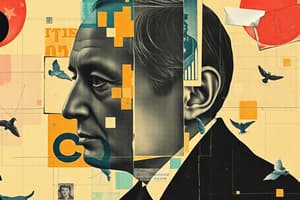Podcast
Questions and Answers
What does the Quantity Theory of Money (MV = PQ) state?
What does the Quantity Theory of Money (MV = PQ) state?
- Inflation occurs when demand for goods and services is greater than supply
- There is a direct relationship between the quantity of money and the price level (correct)
- The value of money depends on the prices of goods and services
- Inflation is a sustained increase in the general price level of goods and services
What is the value of money according to the text?
What is the value of money according to the text?
- The purchasing power of an individual (correct)
- The average price level
- The number of times money is spent
- The rate at which the average price level of goods increases
What type of inflation takes place when demand for goods and services is greater than supply?
What type of inflation takes place when demand for goods and services is greater than supply?
- Demand Pull (correct)
- Stagflation
- Cost-push
- Hyperinflation
What does the equation M=P represent?
What does the equation M=P represent?
What is the velocity of money (V) in the Quantity Theory of Money (MV = PQ)?
What is the velocity of money (V) in the Quantity Theory of Money (MV = PQ)?
Monetary theory states that the value of money depends on the prices of goods and services
Monetary theory states that the value of money depends on the prices of goods and services
Inflation is a qualitative measure of the rate at which the average price level of goods and services in an economy increases over a period of time
Inflation is a qualitative measure of the rate at which the average price level of goods and services in an economy increases over a period of time
Demand-pull inflation is due to full employment and population explosion
Demand-pull inflation is due to full employment and population explosion
Cost-push inflation occurs when the prices of raw materials, oil, or the salaries of employees decrease
Cost-push inflation occurs when the prices of raw materials, oil, or the salaries of employees decrease
The Quantity Theory of Money states that MV = PQ where M is the quantity of money, Q is the number/quantity of goods and services, P is the average price level, and V is the velocity of money
The Quantity Theory of Money states that MV = PQ where M is the quantity of money, Q is the number/quantity of goods and services, P is the average price level, and V is the velocity of money
Flashcards are hidden until you start studying
Study Notes
Quantity Theory of Money
- The Quantity Theory of Money is represented by the equation MV = PQ, where:
- M is the quantity of money
- V is the velocity of money
- P is the average price level
- Q is the number/quantity of goods and services
Inflation
- Inflation is a qualitative measure of the rate at which the average price level of goods and services in an economy increases over a period of time
- Types of inflation:
- Demand-pull inflation: occurs when demand for goods and services is greater than supply
- Cost-push inflation: occurs when the prices of raw materials, oil, or the salaries of employees decrease
Value of Money
- The value of money depends on the prices of goods and services
- The equation M=P represents the value of money, where M is the quantity of money and P is the average price level
Studying That Suits You
Use AI to generate personalized quizzes and flashcards to suit your learning preferences.




